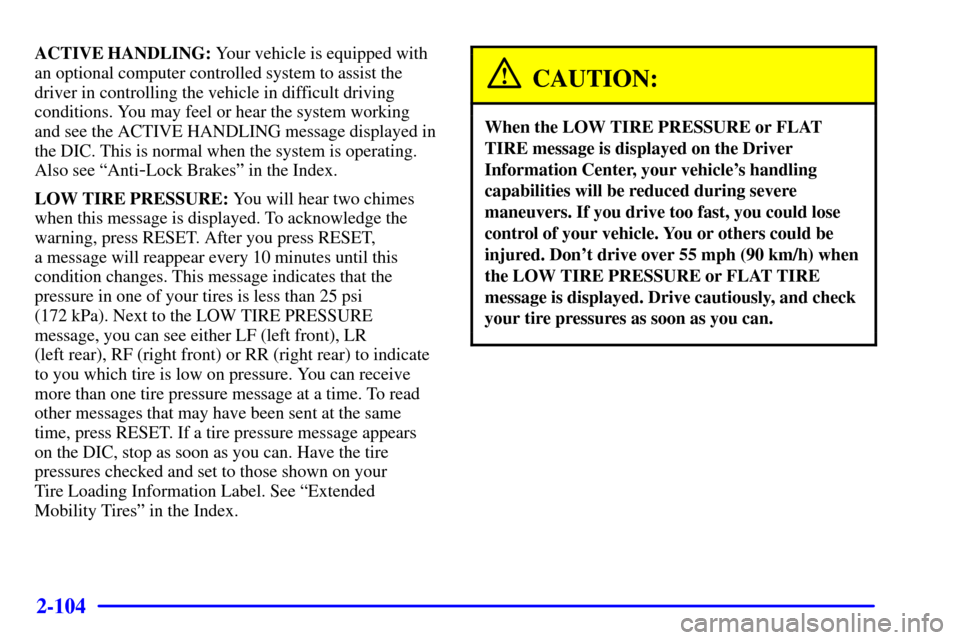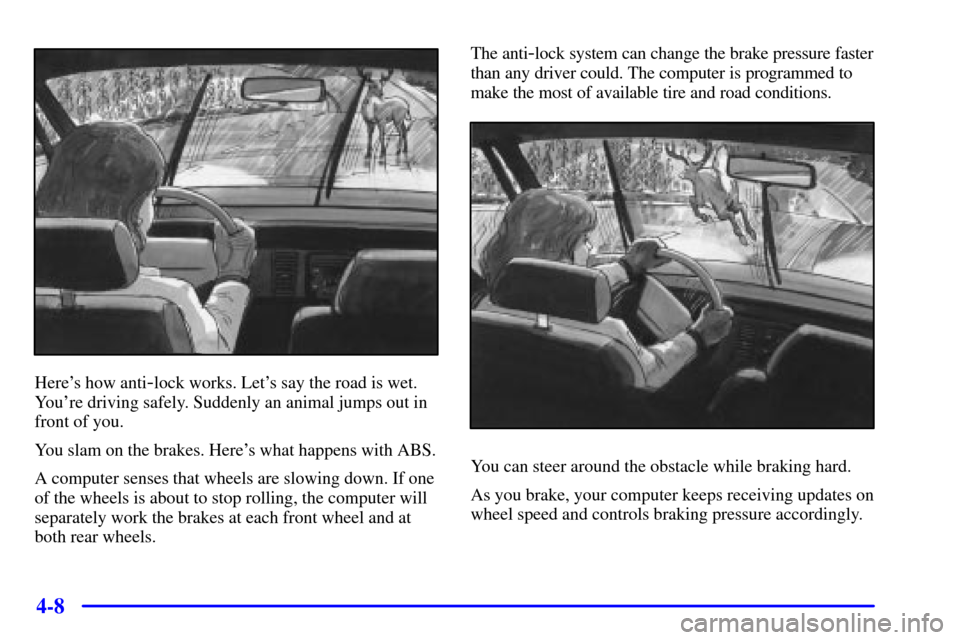2000 CHEVROLET CORVETTE brakes
[x] Cancel search: brakesPage 157 of 361

2-99
SERVICE ABS (Anti-Lock Brake System): If the
SERVICE ABS message is displayed when you are
driving, stop as soon as possible and turn the ignition
off. Then start the engine again to reset the system.
If the message stays on, or comes back on again while
you are driving, your vehicle is in need of service.
If the regular brake system warning light isn't on, you
still have brakes, but don't have anti
-lock brakes.
If the regular brake system light is also on, you don't
have anti
-lock brakes and there is a problem with your
brakes. See ªBrake System Warning Lightº earlier in
this section.
If the SERVICE ABS message is being displayed, your
traction control system and the optional active handling
system will also be disabled. The driver information
center will scroll three messages: SERVICE ABS,
SERVICE TRACTION SYS and SERVICE ACTIVE
HNDLG, and the instrument cluster car icon will be
illuminated. The driver can acknowledge these messages
by pressing the reset button three times. When the
service message is displayed the computer controlled
systems will not assist the driver and you should have
the system repaired as soon as possible. Adjust your
driving accordingly.SERVICE COLUMN LOCK: If the system that
controls the locking and unlocking of the steering
column does not work properly, have the vehicle towed
to a dealer for service.
PULL KEY
- WAIT 10 SEC: If this message comes
on, the steering column lock system has detected a
problem while engaging the steering column lock. This
message may occur when the ignition key is removed
and reinserted before the steering column lock system
fully locks or unlocks the steering column. To
acknowledge that you have read this message, and to
clear it from the display, remove the ignition key and
wait 10 seconds before reinserting the key into the
ignition. If you attempt to operate your vehicle without
removing the key for 10 seconds, the vehicle's fuel
system will shut when you reach 1.5 mph (2.4 km/h).
If the message stays on after removing the key and
waiting 10 seconds, have your vehicle taken to an
authorized dealer as soon as possible for diagnosis
and repair.
Page 162 of 361

2-104
ACTIVE HANDLING: Your vehicle is equipped with
an optional computer controlled system to assist the
driver in controlling the vehicle in difficult driving
conditions. You may feel or hear the system working
and see the ACTIVE HANDLING message displayed in
the DIC. This is normal when the system is operating.
Also see ªAnti
-Lock Brakesº in the Index.
LOW TIRE PRESSURE: You will hear two chimes
when this message is displayed. To acknowledge the
warning, press RESET. After you press RESET,
a message will reappear every 10 minutes until this
condition changes. This message indicates that the
pressure in one of your tires is less than 25 psi
(172 kPa). Next to the LOW TIRE PRESSURE
message, you can see either LF (left front), LR
(left rear), RF (right front) or RR (right rear) to indicate
to you which tire is low on pressure. You can receive
more than one tire pressure message at a time. To read
other messages that may have been sent at the same
time, press RESET. If a tire pressure message appears
on the DIC, stop as soon as you can. Have the tire
pressures checked and set to those shown on your
Tire Loading Information Label. See ªExtended
Mobility Tiresº in the Index.
CAUTION:
When the LOW TIRE PRESSURE or FLAT
TIRE message is displayed on the Driver
Information Center, your vehicle's handling
capabilities will be reduced during severe
maneuvers. If you drive too fast, you could lose
control of your vehicle. You or others could be
injured. Don't drive over 55 mph (90 km/h) when
the LOW TIRE PRESSURE or FLAT TIRE
message is displayed. Drive cautiously, and check
your tire pressures as soon as you can.
Page 204 of 361

4-6
Control of a Vehicle
You have three systems that make your vehicle go where
you want it to go. They are the brakes, the steering and
the accelerator. All three systems have to do their work
at the places where the tires meet the road.
Sometimes, as when you're driving on snow or ice, it's
easy to ask more of those control systems than the tires
and road can provide. That means you can lose control
of your vehicle. (Also see ªTraction Control System
(TCS)º and ªActive Handling Systemº in the Index.)
Braking
Braking action involves perception time and
reaction time.
First, you have to decide to push on the brake pedal.
That's perception time. Then you have to bring up
your foot and do it. That's reaction time.
Average reaction time is about 3/4 of a second.
But that's only an average. It might be less with one
driver and as long as two or three seconds or more with
another. Age, physical condition, alertness, coordination
and eyesight all play a part. So do alcohol, drugs and
frustration. But even in 3/4 of a second, a vehicle
moving at 60 mph (100 km/h) travels 66 feet (20 m).
That could be a lot of distance in an emergency, so
keeping enough space between your vehicle and others
is important.
And, of course, actual stopping distances vary greatly
with the surface of the road (whether it's pavement or
gravel); the condition of the road (wet, dry, icy); tire
tread; the condition of your brakes; the weight of
the vehicle and the amount of brake force applied.
Page 205 of 361

4-7
Avoid needless heavy braking. Some people drive
in spurts
-- heavy acceleration followed by heavy
braking
-- rather than keeping pace with traffic.
This is a mistake. Your brakes may not have time
to cool between hard stops. Your brakes will wear out
much faster if you do a lot of heavy braking. If you
keep pace with the traffic and allow realistic following
distances, you will eliminate a lot of unnecessary
braking. That means better braking and longer
brake life.
If your engine ever stops while you're driving, brake
normally but don't pump your brakes. If you do,
the pedal may get harder to push down. If your engine
stops, you will still have some power brake assist.
But you will use it when you brake. Once the power
assist is used up, it may take longer to stop and the
brake pedal will be harder to push.
Anti-Lock Brakes (ABS)
Your vehicle has anti-lock brakes (ABS). ABS is an
advanced electronic braking system that will help
prevent a braking skid.
When you start your engine and begin to drive away,
your anti
-lock brake system will check itself. You may
hear a momentary motor or clicking noise while this test
is going on, and you may even notice that your brake
pedal moves a little. This is normal.
If there's a problem with
the anti
-lock brake system,
this warning light will stay
on. See ªAnti
-Lock Brake
System Warning Lightº
in the Index.
Page 206 of 361

4-8
Here's how anti-lock works. Let's say the road is wet.
You're driving safely. Suddenly an animal jumps out in
front of you.
You slam on the brakes. Here's what happens with ABS.
A computer senses that wheels are slowing down. If one
of the wheels is about to stop rolling, the computer will
separately work the brakes at each front wheel and at
both rear wheels.The anti
-lock system can change the brake pressure faster
than any driver could. The computer is programmed to
make the most of available tire and road conditions.
You can steer around the obstacle while braking hard.
As you brake, your computer keeps receiving updates on
wheel speed and controls braking pressure accordingly.
Page 207 of 361

4-9
Remember: Anti-lock doesn't change the time you need
to get your foot up to the brake pedal or always decrease
stopping distance. If you get too close to the vehicle in
front of you, you won't have time to apply your brakes
if that vehicle suddenly slows or stops. Always leave
enough room up ahead to stop, even though you have
anti
-lock brakes.
Using Anti
-Lock
Don't pump the brakes. Just hold the brake pedal down
firmly and let anti
-lock work for you. You may hear
a motor or clicking noise and feel the brake pedal move
a little during a stop, but this is normal.
Braking in Emergencies
With anti-lock, you can steer and brake at the same
time. In many emergencies, steering can help you more
than even the very best braking.
Traction Control System (TCS)
Your vehicle has a traction control system called
TCS that limits wheel spin. This is especially useful in
slippery road conditions. The system operates only if
it senses that the rear wheels are spinning too much or
are beginning to lose traction. When this happens, the
system works the rear brakes and reduces engine power
(by closing the throttle and managing engine spark) to
limit wheel spin.
The TRACTION SYSTEM ACTIVE message will
come on when the TCS system is limiting wheel spin.
See ªTRACTION SYSTEM ACTIVE Messageº in
the Index. You may feel or hear the system working,
but this is normal.
If your vehicle is in cruise control when the TCS
system begins to limit wheel spin, the cruise control
will automatically disengage. When road conditions
allow you to safely use it again, you may re
-engage the
cruise control. (See ªCruise Controlº in the Index.)
Page 209 of 361

4-11
Active Handling System (Option)
The optional Active Handling System is a computer
controlled system that helps the driver maintain
directional control of the vehicle in difficult driving
conditions. This is accomplished by selectively
applying any one of the vehicle's brakes.
When you first start your vehicle and begin to drive
away (6 mph (10 km/h)), the message ACT HNDLG
WARMING UP may be displayed in the DIC, the
instrument cluster light will be on, and a chime will
sound. This is normal. You can acknowledge this
message by pressing the RESET button. The Active
Handling System performance is affected until the
message, WARM UP COMPLETE, is displayed
in the DIC.
In cold weather, the ACT HNDLG WARMING UP
message may continue up to 12 mph (20 km/h).
The Active Handling System is off until the WARM
UP COMPLETE message is displayed.
The ACTIVE HANDLING message will come on when
the system is operating. See ªDriver Information Center
Messagesº in the Index for more information. You may
also feel or hear the system working. This is normal.
The SERVICE ACTIVE
HNDLG message will be
displayed, the instrument
cluster light will come on,
and a chime will sound to
let you know if there is a
problem with the system.
See ªDriver Information
Center Messagesº in the
Index for more information.
When this light and the SERVICE ACTIVE HNDLG
message are on, the system is not operational. Adjust
your driving accordingly.
The Active Handling System comes on automatically
whenever you start your vehicle. To help maintain
directional control of the vehicle, you should always
leave the system on. You can turn the system off if you
ever need to. If you turn the Active Handling System
off, the Traction Control System will also be turned off.
Adjust your driving accordingly.
To turn the system off, press the ACTIVE HANDLING
button on the console. You can turn the system on and off
at any time by pressing the button. The DIC will display
the appropriate message when you push the button.
Page 211 of 361

4-13
The traction you can get in a curve depends on the
condition of your tires and the road surface, the angle at
which the curve is banked, and your speed. While you're
in a curve, speed is the one factor you can control.
Suppose you're steering through a sharp curve. Then you
suddenly accelerate. Both control systems
-- steering and
acceleration
-- have to do their work where the tires meet
the road. Adding the sudden acceleration can demand too
much of those places. You can lose control. Refer to
ªTraction Control Systemº in the Index.
What should you do if this ever happens? Ease up on
the accelerator pedal, steer the vehicle the way you want
it to go, and slow down.
Speed limit signs near curves warn that you should
adjust your speed. Of course, the posted speeds are
based on good weather and road conditions. Under less
favorable conditions you'll want to go slower.
If you need to reduce your speed as you approach a
curve, do it before you enter the curve, while your front
wheels are straight ahead.Try to adjust your speed so you can ªdriveº through
the curve. Maintain a reasonable, steady speed. Wait to
accelerate until you are out of the curve, and then
accelerate gently into the straightaway.
Steering in Emergencies
There are times when steering can be more effective
than braking. For example, you come over a hill and
find a truck stopped in your lane, or a car suddenly pulls
out from nowhere, or a child darts out from between
parked cars and stops right in front of you. You can
avoid these problems by braking
-- if you can stop
in time. But sometimes you can't; there isn't room.
That's the time for evasive action
-- steering around
the problem.
Your vehicle can perform very well in emergencies
like these. First apply your brakes. (See ªBraking in
Emergenciesº earlier in this section.) It is better to
remove as much speed as you can from a possible
collision. Then steer around the problem, to the left
or right depending on the space available.